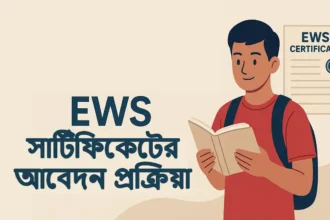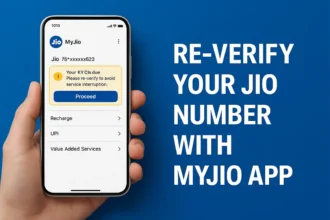How to Navigate the Centralised Admission Portal for UG Admission
West Bengal সরকার উচ্চশিক্ষা প্রক্রিয়াকে আরও সহজ ও স্বচ্ছ করতে চালু করেছে Centralised Admission Portal। এই পোর্টালের মাধ্যমে ছাত্রছাত্রীরা এক জায়গা থেকেই রাজ্যের ৪৬১টি Government ও Government Aided কলেজ/বিশ্ববিদ্যালয়ে আবেদন করতে পারবে। এখানে রয়েছে মোট ৭২৩০টি Courses/Programmes, যেখানে Higher Secondary বা সমতুল্য পরীক্ষায় উত্তীর্ণ শিক্ষার্থীরা নিজেদের পছন্দ অনুযায়ী বিষয় ও প্রতিষ্ঠান বেছে নিতে পারে।
এই পোর্টাল একটি Single Window Gateway হিসেবে কাজ করে, যেখানে ছাত্রছাত্রীরা একই প্রোফাইল ব্যবহার করে একাধিক কলেজ ও কোর্সে আবেদন করতে পারে।
Centralised Admission Portal Quick View
| বিষয় | তথ্য |
|---|---|
| Portal Name | Centralised Admission Portal |
| Purpose | UG Admission |
| Developed By | Govt. of West Bengal |
| Helpline No | 1800-102-8014 / 9147052383 / 9147052384 / 9147052385 |
| support@wbcap.in | |
| Website | https://wbcap.in/ |
| Mobile App | WBCAP APK Download |
Centralised Admission Portal Application Process
Section 1: Registration and Profile Creation
শুরুতেই ছাত্রছাত্রীদের Centralised Admission Portal এ রেজিস্ট্রেশন করতে হবে।
- অফিসিয়াল ওয়েবসাইটে যান: https://wbcap.in/
- “New Applicant Registration” অপশনে ক্লিক করুন।
- নাম, জন্মতারিখ, মোবাইল নম্বর, ইমেইল, HS রোল নম্বর প্রভৃতি তথ্য দিন।
- একটি প্রোফাইল তৈরি হবে যেখানে প্রয়োজনীয় ডকুমেন্ট আপলোড করতে হবে।
Section 2: Checking of Eligibility
প্রোফাইল তৈরি করার পর ছাত্রছাত্রীরা নিজের যোগ্যতা যাচাই করতে পারবে।
- কলেজ, বিশ্ববিদ্যালয়, কোর্স বা জেলা অনুযায়ী Eligibility চেক করা যাবে।
- এভাবে সহজেই বোঝা যাবে কোন কলেজ বা কোর্সে আবেদন করা সম্ভব।
Section 3: Search Your Preferred Institutions and Courses
এই পোর্টালে একটি Smart Search System রয়েছে।
- জেলা, কলেজ, বিশ্ববিদ্যালয়, কোর্স বা বিষয় অনুযায়ী সার্চ করা যায়।
- এতে ছাত্রছাত্রীরা সহজেই নিজের পছন্দের কলেজ ও কোর্স বেছে নিতে পারে।
Section 4: Filling Application
- প্রোফাইল তৈরি হওয়ার পর লগইন করুন।
- Eligibility চেক করুন।
- সর্বোচ্চ ২৫টি কোর্স/প্রোগ্রামে আবেদন করা যাবে।
- আবেদন করার সময় প্রতিটি কোর্সকে পছন্দ অনুযায়ী র্যাঙ্ক করতে হবে।
Section 5: Preference List
- Preference List খুব সতর্কতার সাথে তৈরি করতে হবে।
- সিট এলটমেন্ট এই তালিকার উপর ভিত্তি করেই হবে।
- আবেদন চলাকালীন সময়ে Preference পরিবর্তন করা যাবে।
Section 6: Submission of Application
- সব তথ্য Save করার পর Application Auto-Submit হয়ে যাবে।
- প্রতিটি আবেদনকারীর জন্য একটি Unique Application Number তৈরি হবে।
Section 7: Merit List and Seat Allotment
- Merit Index প্রকাশিত হবে কলেজ/বিশ্ববিদ্যালয়ের নিয়ম অনুযায়ী।
- সাধারণ ও ক্যাটাগরি ভিত্তিক উভয় Merit List তৈরি হবে।
- সিট এলটমেন্টের রেজাল্ট অনলাইনে পাওয়া যাবে।
Section 8: Admission Process
- সিট পেলে ছাত্রছাত্রীকে Online Admission Fee জমা দিতে হবে।
- পেমেন্ট করার পর Provisional Admission Slip ডাউনলোড করতে হবে।
Section 9: Upgradation Round
- প্রথম Preference না পেলে Upgradation Round-এ অংশ নেওয়া যাবে।
- শুধুমাত্র High Preference List বিবেচনা করা হবে।
- আপগ্রেডেশন না চাইলে পূর্ববর্তী ভর্তি Valid থাকবে।
Section 10: Document Verification
HEI (Higher Education Institution) এ গিয়ে Original Documents Verification করতে হবে।
প্রয়োজনীয় ডকুমেন্টস:
- Madhyamik Admit Card/Marksheet (Age Proof)
- HS Admit Card/Marksheet
- Caste Certificate (যদি থাকে)
- Disability Certificate (যদি থাকে)
- Aadhaar Card
- Provisional Admission Slip
- Valid Photo ID Proof
- Bank Account Details
Section 11: Final Admission
ডকুমেন্ট Verification সম্পন্ন হলে Final Admission কনফার্ম হবে।
যদি কোনো অসঙ্গতি পাওয়া যায় তাহলে ভর্তি বাতিল হয়ে যাবে।
Section 12: Cancellation and Refund
- ছাত্রছাত্রীরা চাইলে Admission বাতিল করতে পারবে।
- Refund Admission প্রক্রিয়া শেষ হওয়ার পর ব্যাংক অ্যাকাউন্টে ফেরত আসবে।
Required Documents for Registration
| ডকুমেন্ট | ফরম্যাট ও সাইজ |
|---|---|
| Class 10 Marksheet | PDF (Max 2MB) |
| Class 12 Marksheet | PDF (Max 2MB) |
| Caste Certificate (যদি থাকে) | PDF (Max 2MB) |
| PWD Certificate (যদি থাকে) | PDF (Max 2MB) |
| Identity Proof (Aadhaar/Passport/DL) | PDF (Max 2MB) |
| Banglar Siksha ID / ABC ID (যদি থাকে) | – |
| Photo | JPG/PNG (Max 2MB) |
| Signature | JPG/PNG (Max 1MB) |
| Guardian Bank Account Proof | JPG/PNG/PDF (Max 2MB) |
Benefits of Centralised Admission Portal
সেন্ট্রালাইজড অ্যাডমিশন পোর্টাল শিক্ষার্থীদের, শিক্ষা প্রতিষ্ঠানগুলোর এবং পুরো ভর্তি প্রক্রিয়ার জন্য অনেক গুরুত্বপূর্ণ সুবিধা নিয়ে আসে। এর কিছু প্রধান সুবিধা নিচে দেওয়া হলো—
১. সহজ ও একত্রিত প্রক্রিয়া
এই পোর্টাল একটি কেন্দ্রীয় প্ল্যাটফর্ম সরবরাহ করে যেখানে শিক্ষার্থীরা একাধিক কোর্স এবং প্রতিষ্ঠানে একটিমাত্র আবেদন ফর্ম ব্যবহার করে আবেদন করতে পারে। ফলে আলাদা আলাদা প্রতিষ্ঠানে গিয়ে ফর্ম পূরণের ঝামেলা থাকে না।
২. সময় ও খরচ সাশ্রয়
সেন্ট্রালাইজড অ্যাডমিশন পোর্টালের মাধ্যমে আবেদন করলে শিক্ষার্থীরা আলাদা আলাদা ফর্ম পূরণের জন্য যে অতিরিক্ত সময় ও পরিশ্রম করতে হতো তা বাঁচে। পাশাপাশি বিভিন্ন প্রতিষ্ঠানে যাতায়াতের খরচও কমে যায়।
৩. বেশি সুযোগ ও পছন্দ
এই পোর্টালে শিক্ষার্থীরা বিভিন্ন কোর্স ও প্রতিষ্ঠানের তথ্য সহজেই পায়। কোন কলেজে কি কোর্স আছে, যোগ্যতার মানদণ্ড কি, কত আসন খালি আছে—সব তথ্য পাওয়া যায়। ফলে শিক্ষার্থীদের সামনে অনেক বেশি বিকল্প ও সুযোগ তৈরি হয়।
৪. মেধাভিত্তিক নির্বাচন
সেন্ট্রালাইজড অ্যাডমিশন পোর্টাল সাধারণত মেধার ভিত্তিতে ভর্তি নিশ্চিত করে। যেমন শিক্ষাগত যোগ্যতা, প্রবেশিকা পরীক্ষার ফলাফল ও অন্যান্য মানদণ্ড বিবেচনা করা হয়। এর ফলে ভর্তি প্রক্রিয়া ন্যায্য ও স্বচ্ছ হয়।
৫. সহজ যোগাযোগ ব্যবস্থা
এই পোর্টাল শিক্ষার্থী ও প্রতিষ্ঠানের মধ্যে যোগাযোগের মাধ্যম হিসেবে কাজ করে। ভর্তি প্রক্রিয়া সম্পর্কিত নোটিফিকেশন, আপডেট, কাউন্সেলিং এর তারিখ, আসন বন্টন ও ডকুমেন্ট যাচাইয়ের তথ্য এখান থেকে পাওয়া যায়।
৬. কার্যকর আসন বণ্টন
সেন্ট্রালাইজড অ্যাডমিশন পোর্টাল একটি স্বয়ংক্রিয় সিস্টেম ব্যবহার করে আসন বণ্টন করে। এতে আসন বণ্টন ন্যায্য ও সঠিক হয় এবং পক্ষপাতিত্ব বা ভুলের সুযোগ কম থাকে।
৭. স্বচ্ছতা ও দায়বদ্ধতা
ভর্তি প্রক্রিয়ায় স্বচ্ছতা বজায় রাখতে এই পোর্টাল স্পষ্ট নির্দেশিকা, আসন খালি থাকার তথ্য, কাট-অফ নম্বর এবং অন্যান্য বিস্তারিত তথ্য প্রকাশ করে। পাশাপাশি, সমস্ত কার্যক্রম ও লেনদেনের রেকর্ড থাকায় দায়বদ্ধতাও নিশ্চিত হয়।
৮. সুবিধাজনক ও নমনীয়
ইন্টারনেট সংযোগ থাকলেই শিক্ষার্থীরা যেকোনো জায়গা থেকে, যেকোনো সময় এই পোর্টালে প্রবেশ করতে পারে। ফলে আবেদন জমা দেওয়া, ফলাফল দেখা এবং কাউন্সেলিংয়ে অংশ নেওয়া অনেক সহজ ও সুবিধাজনক হয়।
Available UG Courses on the Centralised Admission Portal
পশ্চিমবঙ্গের স্নাতক পর্যায়ে ভর্তি হওয়ার জন্য তৈরি সেন্ট্রালাইজড অ্যাডমিশন পোর্টাল শিক্ষার্থীদের জন্য নানা ধরনের UG কোর্স বা প্রোগ্রাম অফার করে। সর্বশেষ তথ্য অনুযায়ী, এই পোর্টালে মোট ৭২৩০টি কোর্স/প্রোগ্রাম উপলব্ধ রয়েছে।
এই কোর্সগুলো বিভিন্ন শাখা ও বিষয়কে অন্তর্ভুক্ত করে, যার মাধ্যমে ভিন্ন ভিন্ন শিক্ষাগত আগ্রহ এবং ভবিষ্যতের ক্যারিয়ার লক্ষ্য থাকা শিক্ষার্থীরা নিজেদের জন্য সঠিক কোর্স বেছে নিতে পারে।
| Program Duration | Degree | Specializations |
|---|---|---|
| 3-Year | B.A. | – |
| 3-Year | B.Com. | – |
| 3-Year | B.Sc. | – |
| 3-Year | B.A./B.Sc. | Geography, Economics, Psychology, Food & Nutrition |
| 4-Year | B.A. (Hons/Hons. with Research) | – |
| 4-Year | B.Com. (Hons/Hons. with Research) | – |
| 4-Year | B.Sc. (Hons/Hons. with Research) | – |
| 4-Year | B.A. | – |
| 4-Year | B.Com. | – |
| 4-Year | B.Sc. | – |
| 4-Year | B.Com. | – |
| 4-Year | B.Sc. | – |
| 4-Year | B.A./B.Sc. (Hons./Hons. with Research) | Geography, Economics, Psychology, Food & Nutrition |
| 4-Year | B.A./B.Sc./B.Com. (Honors with core vocational) | – |
| – | BBA | – |
| – | BBM | – |
| – | BCA | – |
Available UG Department on the Centralised Admission Portal
Here is the list of degrees structured in a table format for Arts/Humanities, Science, Commerce, and Other disciplines:
| Discipline | Degree | Specializations |
|---|---|---|
| Arts/Humanities | Bachelor of Arts (BA) | English, History, Political Science, Economics, Sociology, etc. |
| Bachelor of Fine Arts (BFA) | – | |
| Bachelor of Performing Arts (BPA) | – | |
| Bachelor of Journalism and Mass Communication (BJMC) | – | |
| Science | Bachelor of Science (BSc) | Physics, Chemistry, Mathematics, Biology, Computer Science, etc. |
| Bachelor of Computer Applications (BCA) | – | |
| Bachelor of Information Technology (BIT) | – | |
| Bachelor of Statistics (BStat) | – | |
| Commerce | Bachelor of Commerce (BCom) | General, Accounting, Finance, Marketing, etc. |
| Bachelor of Business Administration (BBA) | – | |
| Bachelor of Management Studies (BMS) | – | |
| Others | Bachelor of Social Work (BSW) | – |
| Bachelor of Hotel Management (BHM) | – | |
| Bachelor of Design (BDes) | – | |
| Bachelor of Library Science (BLIS) | – |
পশ্চিমবঙ্গের স্নাতক স্তরের Centralised Admission Portal সিট ক্যাপাসিটি
স্নাতক পর্যায়ের (UG) কোর্সগুলির সিট ক্যাপাসিটি বা আসন সংখ্যা প্রতিটি কোর্স এবং প্রতিষ্ঠানভেদে আলাদা হয়। এটি মূলত নির্ভর করে কয়েকটি বিষয়ের উপর—
- সংশ্লিষ্ট কোর্সটির জনপ্রিয়তা
- প্রতিষ্ঠানের ধারণক্ষমতা
- বিশ্ববিদ্যালয় বা কলেজ কর্তৃপক্ষের বিবেচনা
👉 সুতরাং, একেকটি কলেজে একই বিষয়ের জন্য ভিন্ন সিট সংখ্যা থাকতে পারে।
কিভাবে জানবেন সিট ক্যাপাসিটি?
স্নাতক স্তরের সেন্ট্রালাইজড অ্যাডমিশন পোর্টালে সিট ক্যাপাসিটির তথ্য জানতে হলে আপনাকে আপনার পছন্দের কলেজের নাম দিয়ে সার্চ করতে হবে।
সেখানে আপনি পাবেন—
- কলেজভিত্তিক তথ্য
- প্রতিটি কোর্সের বিস্তারিত বিবরণ
- প্রতিটি প্রতিষ্ঠানে উপলব্ধ আসন সংখ্যা
এইভাবে সহজেই শিক্ষার্থীরা তাদের পছন্দমতো কলেজ ও কোর্সের সিট ক্যাপাসিটি সম্পর্কে পরিষ্কার ধারণা পেতে পারে।
Centralised Admission Portal র মাধ্যমে স্নাতক স্তরের কাউন্সেলিং প্রক্রিয়া
স্নাতক (UG) ভর্তির জন্য সেন্ট্রালাইজড অ্যাডমিশন পোর্টাল-এর কাউন্সেলিং প্রক্রিয়া সংশ্লিষ্ট রাজ্য বা প্রতিষ্ঠানের নির্দিষ্ট নিয়ম ও পদ্ধতির উপর নির্ভর করে কিছুটা ভিন্ন হতে পারে। তবে সাধারণত প্রক্রিয়াটি নিম্নলিখিত ধাপগুলির মাধ্যমে সম্পন্ন হয়—
১. রেজিস্ট্রেশন (Registration)
প্রথমে প্রার্থীদের নির্দিষ্ট সময়সীমার মধ্যে সেন্ট্রালাইজড অ্যাডমিশন পোর্টালে রেজিস্ট্রেশন করতে হয়। এখানে ব্যক্তিগত তথ্য ও একাডেমিক যোগ্যতার বিবরণ দিতে হয়।
২. আবেদনপত্র জমা (Application Submission)
রেজিস্ট্রেশনের পর প্রার্থীদের অনলাইনে আবেদনপত্র জমা দিতে হয় এবং সেখানে তাদের পছন্দের কোর্স ও প্রতিষ্ঠানের নাম নির্বাচন করতে হয়।
৩. নথি যাচাই (Document Verification)
আবেদন জমা দেওয়ার পর প্রার্থীদের ডকুমেন্ট ভেরিফিকেশনের জন্য ডাকা হয়। মূল কাগজপত্র ও সত্যায়িত কপি জমা দিতে হয় যাচাইয়ের জন্য।
৪. মেধা তালিকা প্রকাশ (Merit List Publication)
ডকুমেন্ট যাচাই প্রক্রিয়া শেষ হলে কর্তৃপক্ষ মেধা তালিকা প্রকাশ করে। এটি প্রার্থীর একাডেমিক ফলাফল, প্রবেশিকা পরীক্ষার নম্বর বা অন্যান্য নির্ধারিত মানদণ্ডের ভিত্তিতে তৈরি হয়।
৫. আসন বণ্টন (Seat Allotment)
মেধা তালিকার ভিত্তিতে প্রার্থীদের পছন্দ অনুযায়ী কোর্স ও প্রতিষ্ঠানে আসন বণ্টন করা হয়। প্রার্থীরা তাদের বরাদ্দ আসনের তথ্য সেন্ট্রালাইজড অ্যাডমিশন পোর্টালের মাধ্যমে জানতে পারে।
৬. অনলাইন ভর্তি (Online Admission)
যেসব প্রার্থী আসন বরাদ্দ পান, তাদের নির্দিষ্ট সময়সীমার মধ্যে ভর্তি ফি জমা দিয়ে অনলাইনে ভর্তি নিশ্চিত করতে হয়। নির্দিষ্ট সময়সীমার পরে অনলাইন ভর্তি প্রক্রিয়া বন্ধ হয়ে যায়।
৭. আপগ্রেডেশন ও দ্বিতীয় দফার কাউন্সেলিং (Upgradation & Second Round Counseling)
যদি কোনো আসন খালি থাকে বা কেউ ভর্তি না নেয়, তাহলে দ্বিতীয় বা পরবর্তী রাউন্ডে কাউন্সেলিং অনুষ্ঠিত হয়। এতে প্রার্থীরা তাদের আসন আপগ্রেড করতে পারে বা নতুন আসন বণ্টনের সুযোগ পায়।
Centralised Admission Portal স্নাতক কোর্সের ভর্তি ফি
পশ্চিমবঙ্গের সেন্ট্রালাইজড অ্যাডমিশন পোর্টালের মাধ্যমে স্নাতক (UG) স্তরে ভর্তির জন্য যে ভর্তি ফি দিতে হয়, তা প্রতিটি কোর্স, প্রতিষ্ঠান এবং অন্যান্য কারণে ভিন্ন হতে পারে।
প্রতিটি প্রতিষ্ঠানের নিজস্ব নিয়ম অনুযায়ী ভর্তি ফি নির্ধারিত হয় এবং সময়ের সাথে সাথে সেই ফি পরিবর্তিতও হতে পারে।
ভর্তি ফি জানার উপায়
স্নাতক স্তরের কোর্সগুলির সঠিক ও হালনাগাদ ভর্তি ফি জানতে হলে—
- নির্দিষ্ট প্রতিষ্ঠানের ডিটেলস পোর্টাল ওয়েবসাইটে ভিজিট করতে হবে, অথবা
- সরাসরি সংশ্লিষ্ট কলেজ/বিশ্ববিদ্যালয়ের সাথে যোগাযোগ করতে হবে।
তারা আপনাকে নির্দিষ্ট কোর্সের ভর্তি ফি সম্পর্কিত সবচেয়ে সঠিক তথ্য জানাবে।
গুরুত্বপূর্ণ দিক
মনে রাখা জরুরি যে ভিন্ন ভিন্ন প্রতিষ্ঠান এবং কোর্সের জন্য ভর্তি ফি অনেকটা আলাদা হতে পারে। তাই সিদ্ধান্ত নেওয়ার আগে বিভিন্ন প্রতিষ্ঠানের ভর্তি ফি খুঁজে দেখা এবং তুলনা করা বুদ্ধিমানের কাজ।
Exempted Colleges Who are Not Available on Centralised Admission Portal
| Srl | College / Institute |
| 1 | Al Ameen Memorial Minority College |
| 2 | Bankura Christian College |
| 3 | Midnapore College |
| 4 | Milli Al-Ameen College (For Girls) |
| 5 | Panskura Banamali College |
| 6 | Raja Narendralal Khan Women’s College [Gope College] (Autonomous) |
| 7 | Ramkrishna Mission Residential College, Narendrapur |
| 8 | Ramakrishna Mission Vidyamandira, Belur Math |
| 9 | Scottish Church College |
| 10 | Serampore College |
| 11 | Shri Shikshayatan College |
| 12 | St. Paul’s Cathedral Mission College |
| 13 | St. Xavier’s College |
| 14 | Taradevi Harakhchand Kankaria Jain College |
| 15 | The Bhawanipur Education Society College |
| 16 | The Heritage College |
| 17 | Women’s Christian College |
Conclusion:
পশ্চিমবঙ্গের Centralised Admission Portal স্নাতক (UG) স্তরের শিক্ষার্থীদের জন্য একটি অমূল্য সম্পদ, বিশেষ করে যারা সরকারী এবং সরকার-সহায়তা প্রাপ্ত কলেজ/বিশ্ববিদ্যালয়ে ভর্তি হতে চায়। এর সহজ ব্যবহারযোগ্য ইন্টারফেস এবং বিস্তৃত সার্চ অপশন শিক্ষার্থীদের জন্য একটি সুবিধাজনক প্ল্যাটফর্ম প্রদান করে, যাতে তারা তাদের পছন্দের প্রতিষ্ঠান এবং কোর্স/প্রোগ্রাম সহজেই নির্বাচন করতে পারে।
প্রার্থী প্রোফাইল তৈরি করা, যোগ্যতা যাচাই করা, প্রেফারেন্স লিস্ট প্রস্তুত করা এবং সার্চ ফাংশন ব্যবহার করে শিক্ষার্থীরা সহজেই ভর্তি প্রক্রিয়ার মাধ্যমে এগোতে পারে। এই কেন্দ্রীভূত সিস্টেম ভর্তি প্রক্রিয়ায় স্বচ্ছতা, ন্যায্যতা এবং কার্যকারিতা নিশ্চিত করে, যা শিক্ষার্থী ও প্রতিষ্ঠান উভয়ের জন্যই লাভজনক। একজন শিক্ষার্থীর জন্য এই পোর্টাল কার্যকরভাবে ব্যবহার করা এবং সঠিক তথ্যের ভিত্তিতে সিদ্ধান্ত নেওয়া সাফল্যমণ্ডিত UG স্তরের ভর্তি যাত্রার জন্য অত্যন্ত গুরুত্বপূর্ণ।
Frequently Asked Questions (FAQs)
১. Centralised Admission Portal কি?
এটি পশ্চিমবঙ্গের UG স্তরের ভর্তি প্রক্রিয়ার জন্য একটি কেন্দ্রীভূত অনলাইন প্ল্যাটফর্ম।
২. কে UG ভর্তি জন্য আবেদন করতে পারে?
যে শিক্ষার্থী 10+2 (Higher Secondary) বা সমমানের পরীক্ষা পাশ করেছে, সে আবেদন করতে পারে।
৩. কতটি কোর্সে আবেদন করা যাবে?
একজন প্রার্থী একাধিক কলেজে সর্বোচ্চ ২৫টি কোর্সে আবেদন করতে পারে।
৪. Merit List কখন প্রকাশিত হয়?
প্রার্থী দের প্রয়োজনীয় ডকুমেন্ট যাচাই হওয়ার পর Merit List প্রকাশিত হয়।
৫. Admission Fees কিভাবে দেওয়া হয়?
যে প্রার্থীকে সিট বরাদ্দ হয়, তিনি অনলাইনে ভর্তি ফি প্রদান করে Online Admission সম্পন্ন করবেন।
৬. Seat Upgradation সম্ভব কি?
হ্যাঁ, যদি প্রার্থী তার প্রেফারেন্সের উপরের সিট পেতে চায়, তবে Upgradation Round এ অংশ নিতে পারে।
৭. কোন কলেজগুলি Centralised Admission Portal এ নেই?
কিছু স্বায়ত্তশাসিত ও বিশেষ কলেজ পোর্টালে নেই, যেমন St. Xavier’s College, Scottish Church College ইত্যাদি।





